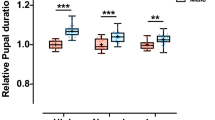Abstract
IN a series of papers, Tate1–4 has described the inheritance and expression of a mutation, white-apricot (w), in the blowfly Calliphora erythrocephala. He showed that this factor is probably situated in the X-chromosome and is recessive to the dominant allele for wild-type eye colour which is located in the homologous section of the Y-chromosome in heterozygous males. No evidence was found of crossing-over between X- and Y-chromosomes in this fly. The object of the present communication is to report a similar case in the fly Muscina stabulans.
This is a preview of subscription content, access via your institution
Access options
Subscribe to this journal
Receive 51 print issues and online access
$199.00 per year
only $3.90 per issue
Buy this article
- Purchase on Springer Link
- Instant access to full article PDF
Prices may be subject to local taxes which are calculated during checkout
Similar content being viewed by others
References
Tate, P., Nature, 160, 361 (1947).
Tate, P., J. Genet., 48, 176 (1947).
Tate, P., J. Genet., 48, 192 (1947).
Tate, P., J. Genet., 48, 338 (1948).
Mackerras, M. J., Aust. J. Exp. Biol. Med. Sci., 11, 45 (1933).
Dichler, H., Amer. Nat., 77, 287 (1943).
Author information
Authors and Affiliations
Rights and permissions
About this article
Cite this article
PATERSON, H. Sex-linked and Sex-limited Mutation of the Fly Muscina stabulans (Fall.) (Muscidae). Nature 181, 932–933 (1958). https://doi.org/10.1038/181932b0
Issue Date:
DOI: https://doi.org/10.1038/181932b0
This article is cited by
Comments
By submitting a comment you agree to abide by our Terms and Community Guidelines. If you find something abusive or that does not comply with our terms or guidelines please flag it as inappropriate.



